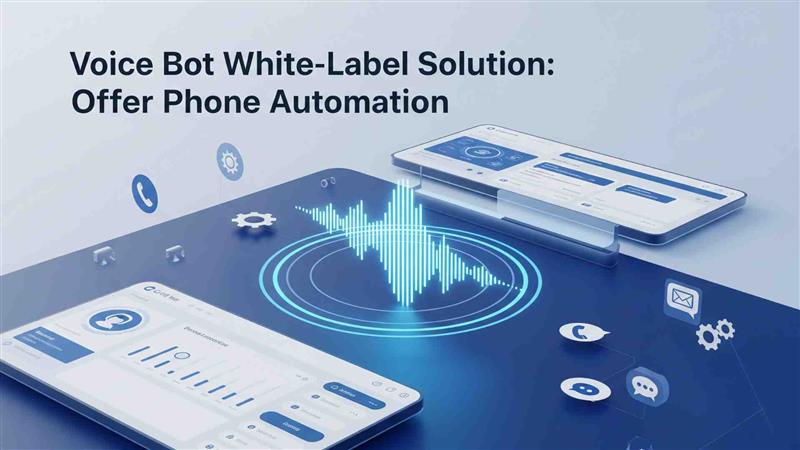Voice bot white-label solution handles infrastructure maintenance and system updates. Phone automation has become essential for modern businesses worldwide. Companies seek intelligent solutions to handle customer calls efficiently. The demand for voice technology creates massive opportunities for service providers.
Table of Contents
Many businesses want to offer voice automation but lack development resources. Building voice technology from scratch requires years of investment. White-label solutions eliminate these barriers.
Service providers can enter the voice automation market quickly through partnerships. Ready-made technology platforms enable rapid deployment under custom branding. This approach generates revenue without substantial upfront development costs.
What Is a Voice Bot White-Label Solution?
A voice bot white-label solution provides ready-to-deploy phone automation technology that partners can rebrand completely. The original technology developer creates and maintains the core platform. Partners customize the branding, interface, and features for their specific markets.
White-label arrangements eliminate the need for extensive technology development. Partners receive fully functional voice automation systems immediately. Customization options enable unique market positioning and competitive advantages.
Partners focus on sales, marketing, and customer relationship management. Revenue sharing models create mutually beneficial business arrangements.
These solutions include comprehensive business packages with training materials and support resources. Implementation assistance ensures successful partner launches. Ongoing technical support maintains system reliability and customer satisfaction.
Core Benefits of White-Label Voice Automation
Immediate Market Entry
Developing voice automation technology internally takes years of dedicated effort. Hiring qualified development teams costs millions in salary and infrastructure investments. Testing and refinement processes add months to deployment schedules.
White-label solutions provide instant access to proven technology platforms. Partners can launch services within weeks instead of years. Pre-built systems reduce risk and accelerate revenue generation significantly.
Market validation becomes possible without massive upfront commitments. Partners can test demand before investing substantial resources. Flexible arrangements allow scaling based on actual customer response.
Significant Cost Reduction
Building internal development capabilities requires ongoing substantial investments. Recruiting experienced engineers proves challenging in competitive talent markets. Infrastructure costs continue growing with increasing system complexity.
White-label partnerships eliminate these overhead expenses entirely. Partners pay revenue shares instead of fixed development costs. Scalable pricing models align expenses with actual business growth.
Marketing investments focus on customer acquisition rather than technology development. Partners leverage existing expertise in relationship management and sales. Resource allocation optimizes around proven business strengths.
Complete Brand Control
Voice bot white-label solutions offer extensive customization capabilities for partner branding. Partners maintain full control over all customer-facing elements. User interfaces reflect partner brand guidelines and visual identity perfectly.
Custom domains and contact information maintain consistent brand experiences. Marketing materials feature partner logos and messaging exclusively. Customers interact with partner brands throughout the entire service experience.
Feature customization enables competitive differentiation within target markets. Partners emphasize capabilities most relevant to their customer demographics. Pricing strategies reflect partner positioning and market approaches.
Essential Voice Bot White-Label Solution Features
Advanced Technology Platform
Quality white-label solutions include sophisticated speech recognition capabilities. Natural language processing handles diverse customer inquiries effectively. Multi-language support enables expansion into global markets.
Integration capabilities connect seamlessly with existing business systems. API frameworks enable custom development and third-party software connections. Cloud-based architecture ensures reliable scalability and performance.
Analytics dashboards provide comprehensive performance insights and detailed reporting. Real-time monitoring tracks system health and customer satisfaction metrics. Automated alerts notify partners about issues requiring immediate attention.
Comprehensive Customization Options
Interface customization tools enable complete visual branding control. Color schemes, logos, and typography reflect partner brand standards. Custom voice recordings create unique audio experiences for customers.
Administrative portals allow partners to manage customer accounts independently. User management systems support various organizational structures and hierarchies. Billing integration enables automated revenue collection and processing.
Documentation and training materials require complete partner branding customization. Support resources maintain consistent messaging throughout customer interactions. Marketing templates accelerate partner promotional campaign development.
Robust Support Infrastructure
Technical support teams provide assistance during implementation and ongoing operations. Comprehensive documentation libraries offer setup and troubleshooting guidance. Video training resources accelerate partner team learning and onboarding.
Regular training sessions keep partners updated on new features and capabilities. Certification programs validate partner expertise and professional competency levels. Marketing support assists with lead generation and customer acquisition strategies.
Dedicated account management ensures partner success and long-term satisfaction. Regular check-ins identify improvement opportunities and potential expansion possibilities. Performance reviews track progress against established business goals and metrics.
Implementation Strategies for Partner Success
Strategic Partner Selection
Successful white-label programs require careful partner evaluation and selection criteria. Ideal partners possess established customer bases and proven market credibility. Technical competency ensures effective system deployment and customer support.
Financial stability enables sustained marketing investments and business growth. Cultural alignment ensures productive long-term partnership relationships. Geographic coverage considerations maximize overall market penetration opportunities.
Comprehensive onboarding programs prepare partners for successful market launches. Technical training covers system administration and troubleshooting procedures. Sales training focuses on value propositions and competitive positioning strategies.
Market Positioning Excellence
Partners must identify unique value propositions within their specific target markets. Industry specialization creates competitive advantages and establishes expertise positioning. Geographic focus enables deeper market penetration and stronger customer relationships.
Pricing strategies should reflect local market conditions and competitive landscapes. Value-based pricing emphasizes customer benefits rather than technical features alone. Flexible pricing models accommodate different customer segments and varying needs.
Marketing messaging must address specific customer pain points and requirements directly. Case studies demonstrate proven results in similar business situations. Customer testimonials build credibility and trust with prospective clients.
Customer Acquisition Excellence
Lead generation strategies should leverage partners’ existing networks and established relationships. Referral programs incentivize customer recommendations and positive word-of-mouth marketing. Content marketing establishes thought leadership and expertise positioning.
Sales processes must effectively communicate value propositions and address customer concerns. Live demonstration capabilities showcase system functionality and benefits clearly. Professional proposal templates accelerate sales cycle completion and closure.
Customer success programs ensure ongoing satisfaction and long-term retention. Regular check-ins identify expansion opportunities and potential service issues. Training programs help customers maximize system utilization and value realization.
Revenue Models and Pricing Approaches
Revenue Sharing Structures
Traditional revenue sharing models split recurring subscription fees between providers and partners. Percentage splits vary based on partner contributions and market conditions. Transparent reporting systems ensure accurate revenue calculations and payments.
Tiered commission structures reward partners for achieving specific volume milestones. Higher percentages incentivize aggressive growth and market expansion efforts. Performance bonuses recognize exceptional results and outstanding achievements.
Upfront licensing fees provide immediate revenue streams for technology providers. Monthly minimum commitments ensure consistent revenue regardless of partner performance. Hybrid models combine multiple revenue streams for balanced financial approaches.
Value-Based Pricing Excellence
Value-based pricing focuses on customer outcomes rather than technology features alone. ROI calculations demonstrate clear financial benefits for customer investments. Cost savings quantification justifies premium pricing strategies effectively.
Industry-specific pricing reflects varying value propositions across different market segments. Enterprise customers typically justify higher prices through operational scale benefits. Small business pricing emphasizes affordability and accessibility factors.
Flexible pricing tiers accommodate varying customer needs and budget constraints. Basic packages provide entry-level functionality at competitive price points. Premium tiers offer advanced features and enhanced support services.
Technology Infrastructure Requirements
Scalable Cloud Architecture
Voice bot white-label solutions require robust cloud infrastructure supporting rapid scaling capabilities. Auto-scaling features handle varying traffic loads automatically and efficiently. Geographic distribution ensures low latency for global customer bases.
Security measures protect sensitive customer data throughout all system interactions. Encryption protocols safeguard voice communications and stored information comprehensively. Compliance certifications meet strict industry regulatory requirements.
Backup and disaster recovery systems ensure continuous service availability. Redundant infrastructure prevents single points of failure and downtime. Service level agreements guarantee specific uptime and performance standards.
Integration Excellence
API frameworks enable seamless integration with existing customer business systems. Pre-built connectors support popular CRM and business software platforms. Custom integration services accommodate unique customer technical requirements.
Real-time data synchronization maintains accuracy across all connected systems. Webhook notifications trigger automated workflows and business processes. Single sign-on capabilities simplify user access management and security.
Mobile applications extend functionality to smartphones and tablet devices. Cross-platform compatibility ensures consistent experiences across all devices. Offline capabilities maintain functionality during temporary connectivity issues.
Quality Assurance and Ongoing Support
Technical Support Excellence
Comprehensive support infrastructures provide assistance during business hours and emergencies. Technical support teams offer expert guidance for complex issues. Knowledge bases provide self-service troubleshooting resources for common problems.
Regular system updates maintain security standards and add new functionality. Scheduled maintenance windows minimize disruption to customer operations. Version control processes ensure smooth upgrade implementations.
Performance monitoring identifies potential issues before they impact customers. Proactive notifications alert partners to important system status changes. Escalation procedures ensure rapid resolution of critical operational problems.
Partner Success Programs
Account management services ensure partner satisfaction and sustainable growth. Regular business reviews assess performance against established partnership goals. Strategic planning sessions identify expansion opportunities and potential improvements.
Training programs keep partners updated on new features and industry best practices. Certification requirements validate ongoing partner competency and expertise levels. Continuing education maintains knowledge as technology continues evolving.
Marketing support assists with lead generation and brand building activities. Co-marketing opportunities leverage combined resources for maximum market impact. Case study development showcases successful implementations and customer results.
Future Market Trends and Opportunities
Artificial Intelligence Evolution
Machine learning improvements will enhance voice recognition accuracy rates significantly. Natural language understanding capabilities will enable more sophisticated customer conversations. Emotional intelligence features will create more empathetic and personalized interactions.
Predictive analytics will anticipate customer needs and requirements proactively. Personalization engines will customize experiences for individual user preferences. Integration with IoT devices will expand automation possibilities across industries.
Global Market Expansion
International market expansion presents substantial growth opportunities for ambitious partners. Localization efforts enable successful entry into new geographic markets. Cultural adaptation ensures appropriate service delivery for diverse populations.
Industry specialization creates competitive advantages within specific vertical markets. Healthcare applications require specialized compliance and enhanced security measures. Financial services demand advanced fraud detection and prevention capabilities.
Emerging market segments offer significant untapped revenue potential for early adopters. Small business automation needs continue to grow rapidly across all industries. Remote work trends increase demand for virtual assistance and automation solutions.
Read More: Voice Bot Training & Optimization: Boost Automation Performance
Conclusion

Voice bot white-label solutions represent exceptional opportunities for service providers seeking rapid technology expansion. Partners can enter growing automation markets without substantial development investments. Revenue potential scales directly with market demand and customer adoption rates.
Success requires careful partner selection and comprehensive implementation strategies. Quality technology platforms ensure customer satisfaction and long-term retention. Ongoing support maintains competitive positioning in rapidly evolving markets.
The voice automation market continues expanding as businesses embrace comprehensive digital transformation. Early adopters gain significant competitive advantages through established market presence. Strategic partnerships create sustainable growth opportunities for all program participants.
Investment in voice bot white-label solutions positions partners for sustained success in automation markets. Technology advancement continues while demand accelerates across industries worldwide. Smart partnerships enable rapid scaling and market leadership positioning.






[…] Read More: Voice Bot White-Label Solution: Offer Phone Automation […]
[…] Read More: Voice Bot White-Label Solution: Offer Phone Automation […]
[…] Voice bot escalation happens when AI systems cannot resolve customer issues. The technology identifies its limitations. It transfers the conversation to human agents. […]
[…] Read More: Voice Bot White-Label Solution: Offer Phone Automation […]
[…] Voice bot customer objections often stem from trust deficits. AI systems must prove competence through intelligent responses. Personal connection attempts through conversational warmth help. Credibility markers like testimonials and guarantees reduce resistance. […]